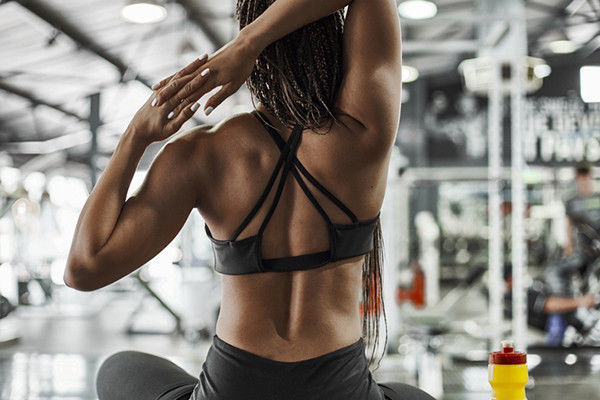Why a strong back matters: Strength and injury prevention
From improved posture to protection from injury, enhanced athletic performance, and pain relief, a strong back is crucial to good health.
Your back is made up of different types of specialized muscles that enable you to move your body so you can twist, turn, bend, stand, walk, run, and lift. Strengthening your back muscles can help you perform everyday activities such as putting on your shoes or closing a window. Strong back muscles can also enhance athletic performance in activities such as swimming or climbing.
The major back muscles include:
Upper-back and mid-back muscles
- trapezius: moves your shoulder and shoulder blade
- rhomboid: pulls your shoulder blade back
- latissimus dorsi: pulls your arm down
Low-back muscles
- erector spinae: extends and stabilizes your spine.
Your back not only allows you to move, it also supports you. Along with muscles in the abdomen, sides, pelvis, hips, and buttocks, the back muscles make up your core. Weak core muscles combined with repeat daily activities such as looking down at your smartphone or typing at your computer can lead to poor posture. Fortunately, strengthening the muscles in the back can help you improve postural problems.
Back muscle training may also help protect you from injury and back pain. As with other muscles, the muscles surrounding your spine can weaken with age or lack of exercise, making you more prone to injury and pain.
The back muscles help support the vertebrae, disks, ligaments, and facet joints. Strong back muscles provide essential support to the spine, reducing the likelihood of strains, sprains, and other injuries that can occur during lifting, bending, or twisting movements. Muscle strains and sprains can result from sports, accidents, or even daily chores such as picking up something from the floor. The painful injury can leave you feeling sore and stiff in the back, buttocks, or thighs for weeks, months, or even longer.
Incorporating exercises targeting the back muscles into a well-rounded fitness program can help support long-term musculoskeletal health and protect you from injury and back pain.
Back exercise safety
Consult with your doctor before starting a new exercise regimen, especially if you have not been active recently, or if you have any injuries (especially a history of back pain or injury) or an unstable chronic health condition, including these:
- heart disease (or multiple risk factors for it)
- a respiratory ailment, such as asthma
- high blood pressure
- joint or bone disease
- a neurologic illness
- diabetes
- a joint replacement.
It is important to practice safe exercise strategies whether working out at home or at the gym. Proper form is essential to avoid injury. A physical trainer can advise you on proper positioning and model the exercise for you. Stop the exercise if you ever experience any pain during a movement.
Body-weight back exercises
The body-weight exercises shown below do not require any special equipment.
In general, aim for eight to 12 repetitions or "reps" of each exercise. If you cannot do all the reps at first, just do what you can, and then gradually increase reps as you improve. Beginners can start with one set of reps on each side (if applicable), working up to three sets as you develop strength. Rest 30 to 90 seconds between sets.
Bridge

Starting position: Lie on your back with your knees bent and feet flat on the floor, hip-width apart and parallel to each other. Place your arms at your sides, palms up. Relax your shoulders against the floor.
Movement: Tighten your buttocks, then lift your hips up off the floor as high as is comfortable. Keep your hips even and spine neutral. Return to the starting position.
Side plank

Starting position: Lie in a straight line on your right side. Support your upper body on your right forearm with your shoulder aligned directly over your elbow. Stack your left foot on top of your right foot. Rest your left hand on your side.
Movement: Tighten your abdominal muscles. Exhale as you lift your right hip and right leg off the floor and raise your left arm toward the ceiling. Keeping shoulders and hips in a straight line, balance on your right forearm and the side of your right foot. Hold for 15 to 60 seconds. Return to the starting position. This is one rep. Finish all reps (2-4), then repeat on your left side. This completes one set.
Superman

Starting position: Lie face down on the floor with your arms extended, palms down, and your legs extended.
Movement: Simultaneously lift your arms, head, chest, and legs up off the floor as high as is comfortable. Hold. Return to the starting position.
More back strengthening exercises
The following exercises require different kinds of equipment — dumbbells, resistance bands, a medicine ball, or kettlebells.
Dumbbells. Depending on your current strength, you might start with as little as a set of 2-pound and 5-pound weights, or 5-pound and 8-pound weights. Add heavier weights as needed.
Resistance bands. Resistance bands look like big, wide rubber bands and are available in a variety of resistance levels.
Kettlebells. Kettlebells look like a ball or bell with a handle. Unlike dumbbells, which you grip at the center of the mass, you grip kettlebells outside of their center of mass. This requires you to exert more muscle force to control the weight, providing a more challenging workout. The lightest kettlebell is usually 5 pounds.
Medicine balls. Medicine balls are about the size of a soccer ball and come in a variety of weights. You can lift or toss them to work your muscles in new ways. Start with a lightweight ball, about 4 to 8 pounds.
Upper back exercises
Bent-over row

Starting position: Stand with a weight in your left hand and a bench or sturdy chair at your right side. Place your right hand and knee on the bench or chair seat. Let your left arm hang directly under your left shoulder, fully extended toward the floor. Your spine should be neutral, and your shoulders and hips squared.
Movement: Squeeze your shoulder blades together, then bend your elbow to slowly lift the weight toward your ribs. Return to the starting position. Finish all reps, then repeat with the opposite arm. This completes one set.
Reverse fly

Starting position: Sit on the edge of a chair, holding a weight in each hand. Hinge forward at your hips, bringing your chest toward your thighs and keeping your back in a straight line. Your arms should hang next to your calves with your palms facing toward your body and thumbs pointing forward.
Movement: Squeeze your shoulder blades together, then slowly lift the weights out to the sides until your arms are at about shoulder height. Keep your elbows soft, not locked. Pause, then return to the starting position.
Pull-down

Starting position: Stand tall with your feet about shoulder-width apart. Hold a band overhead with your arms extended and your hands about 12 to 18 inches apart.
Movement: Bend your elbows slightly and pull your hands down, stretching the band, to about shoulder level. Slowly raise your arms back overhead to the starting position, resisting the pull of the band.
Lower back exercises
Basic swing

Starting position: Stand tall with your feet about shoulder-width apart. Hold a kettlebell with both hands, arms extended down in front of you so the kettlebell hangs between your legs.
Movement: Hinge forward at your hips, shift your weight onto your heels, and sit back, swinging the kettlebell back between your legs. Then press into your heels and stand up as you swing the kettlebell forward to chest height.
Squat and overhead toss

Starting position: Stand tall with your feet about shoulder-width apart, toes pointed out slightly. Hold a medicine ball with both hands at chest height, arms bent.
Movement: Bend your hips and knees, and squat down. Don't let your knees move farther forward than your toes. Press into your heels to stand back up. As you rise, toss the ball overhead and catch it, bringing it back to chest height.











